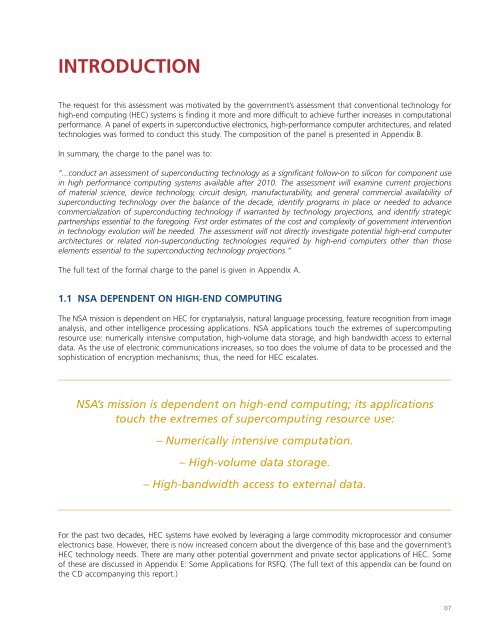Superconducting Technology Assessment - nitrd
Superconducting Technology Assessment - nitrd
Superconducting Technology Assessment - nitrd
You also want an ePaper? Increase the reach of your titles
YUMPU automatically turns print PDFs into web optimized ePapers that Google loves.
INTRODUCTION<br />
The request for this assessment was motivated by the government’s assessment that conventional technology for<br />
high-end computing (HEC) systems is finding it more and more difficult to achieve further increases in computational<br />
performance. A panel of experts in superconductive electronics, high-performance computer architectures, and related<br />
technologies was formed to conduct this study. The composition of the panel is presented in Appendix B.<br />
In summary, the charge to the panel was to:<br />
“...conduct an assessment of superconducting technology as a significant follow-on to silicon for component use<br />
in high performance computing systems available after 2010. The assessment will examine current projections<br />
of material science, device technology, circuit design, manufacturability, and general commercial availability of<br />
superconducting technology over the balance of the decade, identify programs in place or needed to advance<br />
commercialization of superconducting technology if warranted by technology projections, and identify strategic<br />
partnerships essential to the foregoing. First order estimates of the cost and complexity of government intervention<br />
in technology evolution will be needed. The assessment will not directly investigate potential high-end computer<br />
architectures or related non-superconducting technologies required by high-end computers other than those<br />
elements essential to the superconducting technology projections.”<br />
The full text of the formal charge to the panel is given in Appendix A.<br />
1.1 NSA DEPENDENT ON HIGH-END COMPUTING<br />
The NSA mission is dependent on HEC for cryptanalysis, natural language processing, feature recognition from image<br />
analysis, and other intelligence processing applications. NSA applications touch the extremes of supercomputing<br />
resource use: numerically intensive computation, high-volume data storage, and high bandwidth access to external<br />
data. As the use of electronic communications increases, so too does the volume of data to be processed and the<br />
sophistication of encryption mechanisms; thus, the need for HEC escalates.<br />
NSA’s mission is dependent on high-end computing; its applications<br />
touch the extremes of supercomputing resource use:<br />
– Numerically intensive computation.<br />
– High-volume data storage.<br />
– High-bandwidth access to external data.<br />
For the past two decades, HEC systems have evolved by leveraging a large commodity microprocessor and consumer<br />
electronics base. However, there is now increased concern about the divergence of this base and the government’s<br />
HEC technology needs. There are many other potential government and private sector applications of HEC. Some<br />
of these are discussed in Appendix E: Some Applications for RSFQ. (The full text of this appendix can be found on<br />
the CD accompanying this report.)<br />
07










